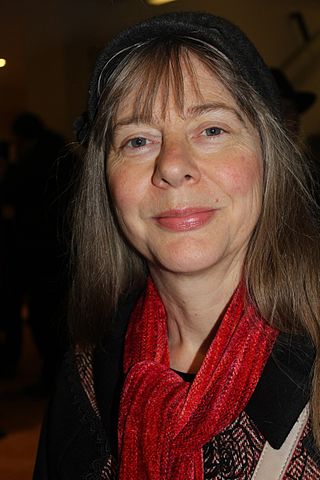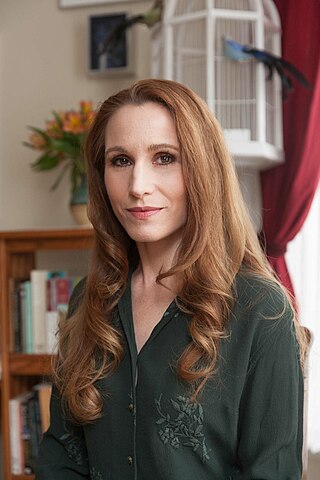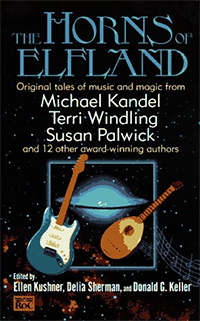Interstitial art is any work of art the basic nature of which falls between, rather than within, the familiar boundaries of accepted genres or media, thus making the work difficult to categorize or describe within a single artistic discipline.
Interstitial art is any work of art the basic nature of which falls between, rather than within, the familiar boundaries of accepted genres or media, thus making the work difficult to categorize or describe within a single artistic discipline.
The word interstitial means "between spaces", and is commonly used to denote "in-betweenness" in several different cultural contexts. Architects refer to the leftover gaps between building walls as "interstitial space", being neither inside any room nor outside the building. Medical doctors have used the term for hundreds of years to refer to a space within the human body that lies in between blood vessels and organs, or in between individual cells. Television station programmers refer to any short piece of content that is neither a show nor a commercial, but is sandwiched between them, as "an interstitial".
In the mid-1990s, Delia Sherman, Ellen Kushner, Terri Windling, Heinz Insu Fenkl, Midori Snyder, Kelly Link, Gavin Grant, Gregory Frost, Theodora Goss, Veronica Schanoes, Carolyn Dunn, Colson Whitehead, and other American writers interested in fantastic literature found themselves commiserating over the common perception that the genre-oriented publishing industry found it difficult to market truly innovative fiction involving unusual, fantastical, or cross-genre elements—because the mainstream literary fiction field demanded stories based in realism, while the fantasy field demanded stories that mostly followed the standard conventions of sword and sorcery or high fantasy. Yet it seemed to the authors that some of the best literature was that which did not quite fit tidily into either category but instead was being discussed in terms of more amorphous, "in-between" descriptors such as "magic realism", "mythic fiction", or "the New Weird". Further, the idea of interstitiality applied to other kinds of "in-between" fiction (unrelated to fantasy) and other "in-between" arts.
Over a period of several years, Kushner and Sherman prompted ongoing discussion about the importance of cultivating artistic "in-betweenness" led to the formulation of the broad concept of interstitial art. In 2002, literary scholar Heinz Insu Fenkl founded ISIS: The Interstitial Studies Institute at the State University of New York at New Paltz, and in 2003–04, Sherman and Kushner and some of their colleagues established the Interstitial Arts Foundation, a 501c(3) nonprofit organization dedicated to developing community and support for artists, arts-industry professionals and audiences whose creative pursuits are interstitial in nature.
In 2007, the Interstitial Arts Foundation published an anthology of interstitial fiction through Small Beer Press titled Interfictions. It features 19 stories from new and established writers in the US, Canada, Australia, and the UK, and fiction translated from Spanish, Hungarian, and French. The anthology strives to "change your mind about what stories can and should do as they explore the imaginative space between conventional genres".
The anthology raised several questions and started many debates on the nature of interstitiality as applied to fiction. Reviewers raised the question of how important the definition, or lack thereof, was to understanding the anthology as a whole and the stories individually. "The 19 stories contained within Interfictions serve as examples but not as points of an argument that could lead to a listing in a Funk and Wagnalls." [1]
Though many of the stories are written by science fiction, fantasy, and horror writers and contain fantastic or supernatural elements, Interfictions is not a genre anthology. "...interstitial fiction mixes and matches these precepts—ghost stories, science fiction, nursery rhymes, detective story, whatever may be handy—as part of a variegated prism to focus on the psychology of existence even while bending its collectively recognized state. ...each 'interfiction' shares this sense of disjointed narrative, but in very different ways that do not lend themselves to easy genre categorization." [2]
Magic realism or magical realism is a style of literary fiction and art. It paints a realistic view of the world while also adding magical elements, often blurring the lines between fantasy and reality. Magic realism often refers to literature in particular, with magical or supernatural phenomena presented in an otherwise real-world or mundane setting, commonly found in novels and dramatic performances. Despite including certain magic elements, it is generally considered to be a different genre from fantasy because magical realism uses a substantial amount of realistic detail and employs magical elements to make a point about reality, while fantasy stories are often separated from reality. Magical realism is often seen as an amalgamation of real and magical elements that produces a more inclusive writing form than either literary realism or fantasy.
Low fantasy, or intrusion fantasy, is a subgenre of fantasy fiction in which magical events intrude on an otherwise-normal world. The term thus contrasts with high fantasy stories, which take place in fictional worlds that have their own sets of rules and physical laws.

Ellen Kushner is an American writer of fantasy novels. From 1996 until 2010, she was the host of the radio program Sound & Spirit, produced by WGBH in Boston and distributed by Public Radio International.
The fantasy of manners is a subgenre of fantasy literature that also partakes of the nature of a comedy of manners. Such works generally take place in an urban setting and within the confines of a fairly elaborate, and almost always hierarchical, social structure. The term was first used in print by science fiction critic Donald G. Keller in an article, The Manner of Fantasy, in the April 1991 issue of The New York Review of Science Fiction.
Rachel Grace Pollack was an American science fiction author, comic book writer, and expert on divinatory tarot.

Cordelia Caroline Sherman, known professionally as Delia Sherman, is an American fantasy writer and editor. Her novel The Porcelain Dove won the Mythopoeic Fantasy Award.

Kelly Link is an American editor and author of short stories. While some of her fiction falls more clearly within genre categories, many of her stories might be described as slipstream or magic realism: a combination of science fiction, fantasy, horror, mystery, and realism. Among other honors, she has won a Hugo award, three Nebula awards, and a World Fantasy Award for her fiction, and she was one of the recipients of the 2018 MacArthur "Genius" Grant.
Small Beer Press is a publisher of fantasy and literary fiction, based in Northampton, Massachusetts. It was founded by Gavin Grant and Kelly Link in 2000 and publishes novels, collections, and anthologies. It also publishes the zine Lady Churchill's Rosebud Wristlet, chapbooks, the Peapod Classics line of classic reprints, and limited edition printings of certain titles. The Press has been acknowledged for its children and young-adult publications, and as a leading small-publisher of literary science-fiction and fantasy.
Heinz Insu Fenkl is an author, editor, translator, and folklorist. His autobiographical novels Memories of My Ghost Brother and Skull Water are widely taught at colleges and universities. He is known internationally for his collection of Korean Folktales and is also an expert on Asian American and Korean literature, including North Korean comics and literature.
Speculative poetry is a genre of poetry that focusses on fantastic, science fictional and mythological themes. It is also known as science fiction poetry or fantastic poetry. It is distinguished from other poetic genres by being categorized by its subject matter, rather than by the poetry's form. Suzette Haden Elgin defined the genre as "about a reality that is in some way different from the existing reality."

Lucy Sussex is an author working in fantasy and science fiction, children's and teenage writing, non-fiction and true crime. She is also an editor, reviewer, academic and teacher, and currently resides in Melbourne, Australia.

Theodora Goss is a Hungarian-American fiction writer and poet. Her writing has been nominated for major awards, including the Nebula, Locus, Mythopoeic, World Fantasy, and Seiun Awards. Her short fiction and poetry have appeared in numerous magazines and anthologies, including Year's Best volumes.

Christopher Barzak is an American author. He has published many short stories, beginning with "A Mad Tea Party" in Lady Churchill's Rosebud Wristlet in 1999. In 2007 he published his debut novel, One for Sorrow, which won the 2008 Crawford Award, and was a nominee for the 2008 Great Lakes Book Award as well as Logo TV's NewNowNext Awards. His second novel, The Love We Share Without Knowing, was a 2008 James Tiptree Jr. Award finalist and a 2009 Nebula Awards finalist for Best Novel. His first full-length short story collection, Before and Afterlives, was the recipient of the Shirley Jackson Award for Best Single-Author Collection in 2013.
Endicott Studio was a nonprofit organization, based in the United States and United Kingdom, that is dedicated to literary, visual, and performance arts inspired by myth, folklore, fairy tales, and the oral storytelling tradition. It was founded in 1987 by Terri Windling, and is co-directed by Windling and Midori Snyder. In 2008, Windling and Snyder won the World Fantasy Award for the Endicott Studio's website and web magazine, The Journal of Mythic Arts.
Bending the Landscape is the title of an award-winning series of LGBT-themed anthologies of short speculative fiction edited by Nicola Griffith and Stephen Pagel. Three books were produced between 1997 and 2002, subtitled Science Fiction, Fantasy, and Horror. Each volume won LGBT or genre awards.

Fantasy is a genre of speculative fiction involving magical elements, typically set in a fictional universe and usually inspired by mythology or folklore. The term "fantasy" can also be used to describe a "work of this genre", usually literary.

The Horns of Elfland is a 1997 fantasy anthology edited by Ellen Kushner, Delia Sherman and Donald G. Keller.
"The Maiden Flight of McCauley's Bellerophon" is a science fiction/magical realism novella by the American writer Elizabeth Hand. It was first published in the Neil Gaiman/Al Sarrantonio-edited anthology Stories: All-New Tales, in 2010, and subsequently republished in Hand's 2012 anthology Errantry: Strange Stories from Small Beer Press.

Nebula Awards Showcase 2005 is an anthology of award-winning science fiction short works edited by American writer Jack Dann. It was first published in trade paperback by Roc/New American Library in March 2005.